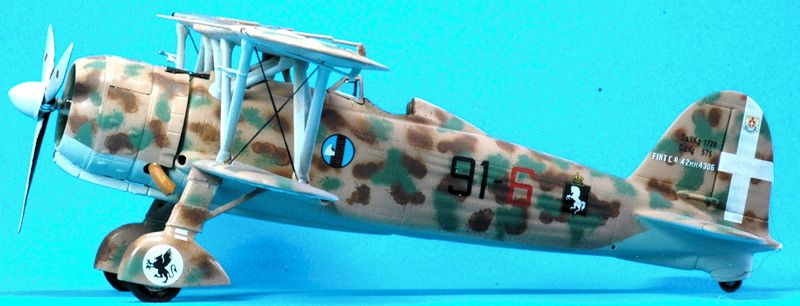
Italeri 1/48 CR.42 'Falco Aces'
| KIT #: | 2702 |
| PRICE: | $51.50 SRP |
| DECALS: | Six options |
| REVIEWER: | Andrew Garcia |
| NOTES: | Eduard etched seat harness |

| HISTORY |
The Fiat CR.42 was a result of Celestino Rosatelli’s innovative aeronautical
designs evolution. Starting with the CR.1 in 1924 the CR.42 first flew May 23,
1938. At a time when low wing, high powered monoplane fighters were flying or in
thier prototype stages this bi-plane aircraft seemed to be an anachronism.
Rather than launch into a discussion on the state of the art at that time let’s
focus on how good this was as the apex of development of the CR series of
fighters. Its test pilot after the first flight stated it was “the ultimate
pilot’s airplane”. The CR.42 was powered by the FIAT A.74 RC.38 radial engine
which produced 828 h.p. at 12, 465 feet.
Even an in line DB601E engine was fitted and tested in
 this airframe
(CR.42DB) during 1942 but by the end of initial flight testing the air ministry
recognized the day of the bi-plane was over and that ended the CR.42.
Its initial armament consisted of two fuselage mounted Breda-SAFAT .50
caliber (12.7mm) guns synchronized to fire through the propeller arc. A field
conversion was available and used to replace the weapons with Breda-SAFAT .30
caliber (7.7mm) guns – as a weight saving gambit.
this airframe
(CR.42DB) during 1942 but by the end of initial flight testing the air ministry
recognized the day of the bi-plane was over and that ended the CR.42.
Its initial armament consisted of two fuselage mounted Breda-SAFAT .50
caliber (12.7mm) guns synchronized to fire through the propeller arc. A field
conversion was available and used to replace the weapons with Breda-SAFAT .30
caliber (7.7mm) guns – as a weight saving gambit.
The CR.42 was produced from February 1939 through June 1943 for a total of 1700 airframes. It evolved from the initial day fighter design into a night fighter, fighter bomber and two seat training airframes. It was well liked by its pilots and served in Italy, Western Europe (Belgium/France), and Mediterranean, Russian and North African fronts. It was even used by the Luftwaffe designated CR.42LW in Italy during 1944 and in France during late 1943 for anti-partisan missions. When the war ended it was still in service stationed in Austria and Croatia. It was an ace maker logging air-to-air combat success for pilots from Italy, Hungary, and Belgium.
| THE KIT |
Italeri have released three versions of their CR.42 Falco kit. The first
release, a CR.42 LW (# 2640) in late 2004 was for the CR.42LW Luftwaffe Night
Attack version with partial landing gear spats. That kit had no bombs which is
an omission. It was followed by # 2653, a CR.42AS Fighter-Bomber, which added a
no spats landing gear (it also has the full spats plastic parts as well) and
some bombs the following year. The Italeri # 2653 release has a wonderful color
printed walk-around booklet that is of great modeling value and tremendous help
in building this aircraft. There are many details on the CR.42 to be found and
understood. The booklet positively helps with and adds a lot to your building
satisfaction. In 2007 the # 2702 Falco Aces release came out featuring the most
produced version of the CR.42 with colors and markings of aces from Italy,
Hungary and Belgium. Italeri’s # 2702 Falco Aces features the required full spat
landing gear and simple (non-dust filter) carburetor air intake (part B27) along
the bottom centerline. The first two releases by Italeri, # 2640 and # 2653,
only have the dust filter air intake (part A40) limiting how many CR.42 versions
you can produce from those kits.
The Italeri CR.42 was well received when it was released and several in-box
reviews appeared giving it positive marks but always indicating that the value
of this kit would be determined after it was built. It was hoped that a new tool
injection plastic kit of the CR.42 from a major manufacturer would reward
modelers with a kit they have been waiting for. Classic Airframes released a
series of CR.42 kits, starting in 1995 with # 402, followed a few years later
with an improved tooling for kits #474, 475, 496, 497, 498, and 499 spanning all
the possible CR.42 variants
including a two seat trainer and seaplane! The Classic Airframes kits are still
available from many hobby shops, eBay and some internet retailers as well. I
mention the CA kit here because it set the standard against which the Italeri
kit would be compared.
The main differences in the three Italeri CR.42 kit releases are in the landing
gear, bomb shackles and carburetor intake parts.
Sadly, very few Italeri CR.42’s have appeared at modeling contests that
I ha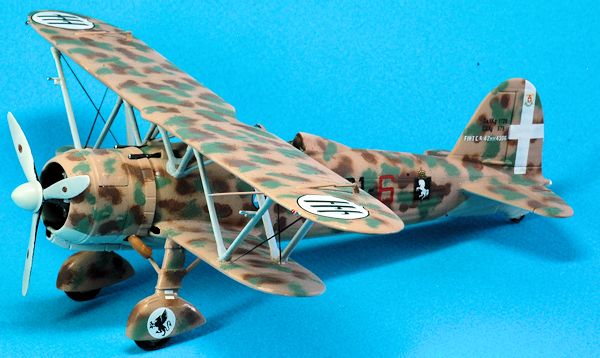 ve been to. I have not seen many in on-line web builds either despite the
many versions and years of sales availability. In general it could be because
bi-planes are more difficult to build. It could also be because the specific kit
releases proved to be difficult to build into nice replicas due to construction
impediments.
ve been to. I have not seen many in on-line web builds either despite the
many versions and years of sales availability. In general it could be because
bi-planes are more difficult to build. It could also be because the specific kit
releases proved to be difficult to build into nice replicas due to construction
impediments.
Scott reviewed the kit stating “For decades we had no 1/48 CR.42 until Classic
Airframes released their short run kit several years ago (about 1996). While
nice, it had some issues in terms of dimensions. This kit was retooled last year
(i.e. about 2007) and produced in a
much nicer version. So it was with much surprise that we find Italeri producing
the same aircraft as a 1/48 kit. Now one might think that I'd compare the two,
but really, it is an apples and oranges thing. The CA kit is a short run
multimedia kit with lots of resin bits and pieces. This is a mainstream
injection molded kit and so does not have the usual resin and photo etched bits
that one finds in short run kits. Not the same animals at all.”
That helped me with answering the question of do I want to buy and build some of
the newly released Italeri models or get down to building the Classic Airframes
kits in the stash. So I bought the Italeri kit and cut into the two large sprues
that fill a pretty good sized box. The clear windscreen was the only part found
on the small clear tree. It has an indentation on the forward portion, probably
to represent the glass screen of the gunsight, though one is not indicated nor
is this feature explained in the box instructions. At first I did not know why
Italeri had this strangely shaped diagram on the front windscreen. Most kit
reviewers overlooked or failed to comment on this windscreen anomaly. I still
don’t really “know” but here’s what I think after reviewing the Italeri kit #
2653 booklets color photos found on page 30. Many web reviewers made no mention
of it or noted it looked like an opening for a telescopic sight. Some were
unsure as to its meaning or purpose. So I will go out on a limb and note the
gunsight is just behind the front windscreen and probably represents the
gunsight glass superimposed on the windscreen as a design simplification. It,
the gunsight, is there at the top of part A2. Once the cockpit is in the
fuselage, the San Giorgio Type B reflector gunsight in the middle of the panel
pokes up behind and below the windscreen – almost touching it. Thus, by placing
it as part of the front windscreen’s “panel lines” it looks like the gun sight
glass is there, sitting on the gunsight, when looked at from certain angles. It
is an interesting alternative but I would have preferred a separate gunsight
with glass on the clear parts tree.
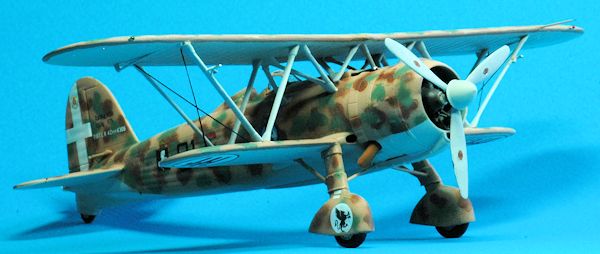 omplete in the box with a seat, instrument panel, rudder pedals, control stick
and side panels. Each kit part has nice detailing; some more than others, but in
my opinion, for a recently released kit from a major manufacturer, the cockpit
is somewhat crude. The cockpit looks like a limited run kit (minus the resin
detail parts), when the short-run kit makers were in their early learning curve
stage working on improving their product. I am all for a simplified cockpit, as
long as the details are there, but in this model I was disappointed with the
crude cockpit detail. Levers are missing or represented by fat round blobs. The
firing button on top of the control stick would be as large as a pie plate if
scaled up to 1:1 scale. The seat and cockpit interior should have round tubular
rails but are represented by solid panels that obstruct the proper installation
of the starboard side panel. The starboard instrument console, parts 48/6 did
not fit without cutting and filing in all four of the Italeri kits that I built.
The lower portion of parts 48/6 hit the cockpit floor part # 3A’s seat pan
“armrest” when I tried to close up the cockpit walls. This could be due to a
slight misalignment of the cockpit walls caused by the loose guide slots. There
is way too much movement when the cockpit parts are brought together to result
in an error free assembly. Italeri improved their cockpit moulding in the later
MC.200 Saetta release.
omplete in the box with a seat, instrument panel, rudder pedals, control stick
and side panels. Each kit part has nice detailing; some more than others, but in
my opinion, for a recently released kit from a major manufacturer, the cockpit
is somewhat crude. The cockpit looks like a limited run kit (minus the resin
detail parts), when the short-run kit makers were in their early learning curve
stage working on improving their product. I am all for a simplified cockpit, as
long as the details are there, but in this model I was disappointed with the
crude cockpit detail. Levers are missing or represented by fat round blobs. The
firing button on top of the control stick would be as large as a pie plate if
scaled up to 1:1 scale. The seat and cockpit interior should have round tubular
rails but are represented by solid panels that obstruct the proper installation
of the starboard side panel. The starboard instrument console, parts 48/6 did
not fit without cutting and filing in all four of the Italeri kits that I built.
The lower portion of parts 48/6 hit the cockpit floor part # 3A’s seat pan
“armrest” when I tried to close up the cockpit walls. This could be due to a
slight misalignment of the cockpit walls caused by the loose guide slots. There
is way too much movement when the cockpit parts are brought together to result
in an error free assembly. Italeri improved their cockpit moulding in the later
MC.200 Saetta release.
The kit cockpit seemed designed for a novice modeler and had rough details. It
greatly benefited from adding some Eduard etched details.
I had much higher expectations of Italeri for this kit after my recent
build of their Macchi MC.200 kit which I found to be quite nice. I even found
the fit of the completed cockpit tub into the fuselage to be a problem on one of
my two initial builds for this kit. This was unexpected since the kit looks like
it is very simple to assemble due to the few parts involved in its construction.
The only saving grace is you cannot see
much of the cockpit once the kit is built due to the small cockpit opening.
However, the bi-plane wings do not obstruct peering into the cockpit and that
means you should think about improving this area, especially the seat and main
panels with some color etched metal.
As our Editor Scott noted, and I too was
perplexed that the general color of the interior was given as light grey and not
the Italian Interior Green found on most Italian aircraft. However, this is the
color used in the aircraft FIAT built after the war. A beautiful restoration
CR.42 was created from parts for an Italian Aviation Museum. It is documented in
color photographs in the booklet that comes with kit # 2653. There are two
options for the instrument sections. Both decals and raised detail panels are
offered for the main instruments and side panel. Also, a seatbelt decal is
provided.
I built my CR.42’s using several variations of cockpit additions.
I think the combination of instrument
decals with some decal solvent on the raised detail panels looked best if you
want to avoid any aftermarket additions. I tried this on a build of the Italeri
CR.42LW version and turned out to be the best
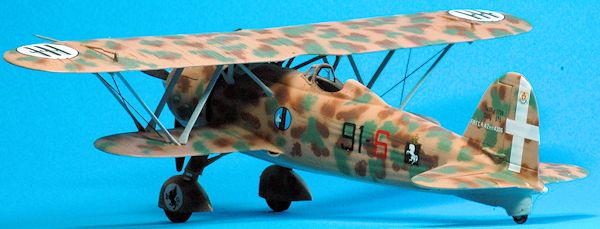 almost OOB route. However, the kit
seat belt decals were incorrect so the build was accompanied by Eduard "EU49017
Seatbelts Italy" pre-painted etched metal seatbelts. I did not use the flat
plastic instrument side panel and main console part 48A and used 6A with
49A/50A. I used the raised detail panels applying the decal with some Microsol.
The solvent worked perfectly to adapt the decal to the raised surface and gave a
better end result. The instructions would have you apply the decal to the flat
plastic parts. By using the raised detail part you can easily paint it flat
black after the decal snuggles down since the decals are raised above the
plastic panel (see photo comparison) for an improved appearance.
almost OOB route. However, the kit
seat belt decals were incorrect so the build was accompanied by Eduard "EU49017
Seatbelts Italy" pre-painted etched metal seatbelts. I did not use the flat
plastic instrument side panel and main console part 48A and used 6A with
49A/50A. I used the raised detail panels applying the decal with some Microsol.
The solvent worked perfectly to adapt the decal to the raised surface and gave a
better end result. The instructions would have you apply the decal to the flat
plastic parts. By using the raised detail part you can easily paint it flat
black after the decal snuggles down since the decals are raised above the
plastic panel (see photo comparison) for an improved appearance.
There is no mention that two steel support rigging cables are part of the end
portions of the struts. They are in an “X” configuration and nowhere to be seen
as a suggested addition in the assembly instructions. They do appear in the
instruction booklets painting guide, decal colors and markings placement
profiles for the aircraft if you look closely. The kit decals should have the
prominent FIAT A.74 engine information plate (see page 24 & 25 of the kit # 2653
booklet). The FIAT “eliche” or propeller logo which is similar to the Hamilton
Standard prop logo (its picture is on pg. 27 kit # 2653 booklet) is close enough
so I will give them an OK on that item.
These are examples of the small details that could have made the kit a
standout and worth its asking price.
Italeri would have you glue all the struts in step 4 and simply flip the upper
wing upside down. Because of its superior engineering all the struts would line
up and drop into the slots on the small lower wing and fuselage. This didn’t
happen as you can expect. The struts require perfect, and I mean perfect
alignment partly because they have raked angles. They are not positioned
vertically upright, that is at a
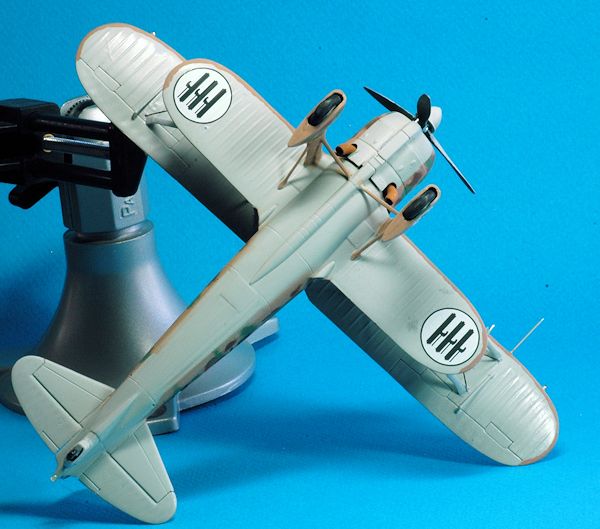 90 degree angle, so gluing those at the
required angle, per the diagram, did not work for me. Although the end points
have accurate angles as part of their design they did not click into place. The
tips have rounded attachment points which make it easy if you are sliding it
into the holes using some liquid glue. My experience building four of these
kits, working them two at a time (simultaneously) was the struts tend to wander
and fall over while you attempt to glue them in place. They also come loose
while drying because some are apparently slightly short and stressed to fit. The
small rounded knobs on the ends tend to slip out of their attachment points
(holes) very frequently. This was most frustrating even when using a special
tool like the SRAM to hold the wings in place while attempting to align and
attach the struts.
90 degree angle, so gluing those at the
required angle, per the diagram, did not work for me. Although the end points
have accurate angles as part of their design they did not click into place. The
tips have rounded attachment points which make it easy if you are sliding it
into the holes using some liquid glue. My experience building four of these
kits, working them two at a time (simultaneously) was the struts tend to wander
and fall over while you attempt to glue them in place. They also come loose
while drying because some are apparently slightly short and stressed to fit. The
small rounded knobs on the ends tend to slip out of their attachment points
(holes) very frequently. This was most frustrating even when using a special
tool like the SRAM to hold the wings in place while attempting to align and
attach the struts.
The engine is complete and nicely done. It is a nice reproduction of the FIAT
A.74 RC.38 radial engine and is similar to the Italeri Macchi MC.200 engine with
two rows of cylinders and separate push rod detailing. However, the pushrods did
not reach the top portion of the cylinder heads which was a shock and
disappointment because they were fine on my Italeri MC.200 build. The CR.42, all
three Italeri produced versions that I built, suffered from short push rods
(part # 23a & 19a). Also, the prominent engine manufacturers’ data plate on the
engine’s port side is missing from the kits decals. It is quite large and
visible on the actual engine. A tiny decal is all that was required to improve
this area.
The landing gear has separate tires and is well moulded on the sprue. The tires
are easy to attach and look the part once on the kit. I did experience
disappointing alignment of the landing gear spats on the Italeri Kit # 2640
requiring putty and sanding to fix the gaps. It seems the spats locating pins
are imprecise causing a joining malformation. The other Italeri CR.42 kits
provide separate lower wheel pants which are removed and those are included as
well as a standard set. This kit had the two types of prop spinner which is
nice. Separate gun barrels, aileron and rudder actuating rods are provided.
Instructions are quite good, providing clear construction sections with color
information given as needed. These are all given as Italeri paint numbers
(Vallejo being the OEM maker for Italeri paints) references as well as a generic
name. The initial Italeri CR.42 kits used Model Master paint numbers so this is
a change for Italeri. My only concern is the Model Master MM2110 Italian Sand
color is very different from the Tamiya Desert Sand (XF-59) that I usually use
on Italian desert camouflaged aircraft. The Tamiya XF-59 has a yellow tint
compared to the Model Master’s brown tint. The Tamiya shade is closer to color
profile drawings. I did not have the newly released Italeri or Vallejo paints on
hand to round out the color comparisons. This move by Italeri to expand their
predict line with paints reminded
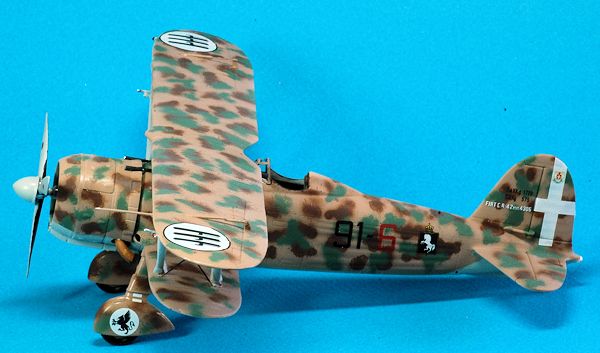 me of the Monogram Models paint line released
many years ago.
me of the Monogram Models paint line released
many years ago.
I think there is a logical explanation for the paint shade differences I saw in
the Italian Sand versus Desert Sand. Looking at the terms in Italian and
assuming a generalization that all Italian aircraft before 1941 were a sand base
with green and brown blotches (check photo references for the different
patterns). From the end of 1941 onwards, the new painting regulations were for a
combination of dark olive green and hazelnut with the green base for temperate
zones, and hazelnut base for desert ones. The color schemes would then use
blotches of the opposite color. Many pre-1941 aircraft were repainted on the
field, according to the new specs, but using already available paints. So that
many Italian aircraft may have been painted a sand base, which is much lighter
than hazelnut, with green blotches. The “sand base” color is probably the Tamiya
shade and the Hazelnut shade is the Model Master MM2110 Italian Sand.
Markings
Markings are provided for six aircraft, five are similarly camouflaged aircraft
with a unique Hungarian camouflage exception, representing pilots who were aces
from their respective countries; Italy, Hungary, and Belgium. The color box art
also supplements the painting information. All of the aircraft are similarly
colored except for the Hungarian AF version. They all have flat light gray
undersides and dark green, brown and light tan mottled upper surfaces. The
Hungarian or Magyar AF version features a brown, green, gray segmented
camouflage. Decals are from Zanchetti Buccinasco, in Milan. They are well
printed, and gloss finished so you will need some dull coating as a finish. I
was surprised to see they were not done by Cartograph but they appear similar to
Cartograph quality. They are very thin, the printing is crisp, small details
such as stencils are clearly printed and are opaque and easy to work with. The
white paint used in the decal is not opaque enough and you might want to paint
those areas white before applying the kit decals. Perhaps the thinness of the
decal prevents the white from blocking a bleed-through of underlying colors.
One important item I noticed after the build – the instructions in Step #4 have
you insert an upper wing pitot, part 38A. I could not find this on any CR.42
aircraft except for some “AS” versions so it might be an incorrect leftover from
the instructions for Italeri kits # 2640 & 2653 and not a correct component for
the mainstream CR.42.
| CONSTRUCTION |
The fuselage halves closed with some minor concerns coming from the cockpit
area. I did not attach the two cowl guns in step 2 preferring to leave them off
until the final, post painting detail step.
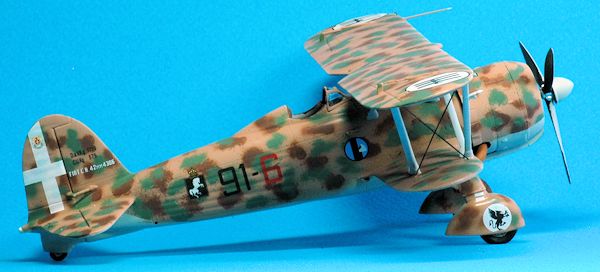 14 lining them up with
the fuselage. Once they were glued onto the wing and fuselage I kept adding
parts working from the center outward. That minimizes alignment problems caused
if you start with the outer struts first. In any event I still had alignment
problems. Some struts were short, not reaching their holes, others moved about
as I tried to glue them in place. It was not the highlight of building this kit.
It kept me from building a kit that I would enjoy sharing with others in a
contest setting. With better kit design and engineering it could have been a
more satisfying experience. The simple change of using square or rectangular
tips and rectangular/square mating insertion holes would have provided a more
secure and robust attachment point. I added the wing wires at this point using
E-Z line. The E-Z line was terrific and when I accidentally hit it during the
build it took the hits like the elastic material should, bouncing back and
maintaining a taut state. I drilled the holes for the rigging, use thin cyano to
secure them and when dry cut the E-Z line with a Xuron sprue cutter and fill the
hole with gap filling cyano followed by a thorough sanding.
14 lining them up with
the fuselage. Once they were glued onto the wing and fuselage I kept adding
parts working from the center outward. That minimizes alignment problems caused
if you start with the outer struts first. In any event I still had alignment
problems. Some struts were short, not reaching their holes, others moved about
as I tried to glue them in place. It was not the highlight of building this kit.
It kept me from building a kit that I would enjoy sharing with others in a
contest setting. With better kit design and engineering it could have been a
more satisfying experience. The simple change of using square or rectangular
tips and rectangular/square mating insertion holes would have provided a more
secure and robust attachment point. I added the wing wires at this point using
E-Z line. The E-Z line was terrific and when I accidentally hit it during the
build it took the hits like the elastic material should, bouncing back and
maintaining a taut state. I drilled the holes for the rigging, use thin cyano to
secure them and when dry cut the E-Z line with a Xuron sprue cutter and fill the
hole with gap filling cyano followed by a thorough sanding.
By the fourth build I think I isolated what was causing the strut misalignment
problem. It all happens with step # 4! In
my opinion parts 12B and 14B throw off the alignment possibly because they are
the wrong length or the attachment points are poorly located. If they are glued
in place after the two inner cabane struts the wing will twist out of alignment
when viewed from above. This problem
will skew the top wing and then all the other struts will be short or not reach
their correct locations. I found by gluing parts 13B and 15B then attaching it
to the wings before the glue has set permits the first alignment to be usable
and sets the foundation for the next steps. I used the SRAM tool to hold the
wing in place (see photo) while attaching the upper wing to parts 13B and 15B.
Once dry I glued in place the outer braces, parts 8/9 and 18/19. Once they set
the rest were put in place and they were much easier to get into their assigned
locations. Doing it this way means parts 12/14 are the last struts to go into
place. It was a struggle to get them, parts 12/14,
to fit so there may be a better way. I
have yet to find a perfect way to get this step go smoothly. It is a big barrier
to creating a desire to build more of these aircraft. Also, I recommend not
attaching the pitot tube at this point as indicated in the instructions. Note –
I think the upper wing pitot for this version of the CR.42 may not be correct –
just my opinion. I tried this on the first build, much to my skepticism and yes
it broke off. I replaced it with a metal pin which was much more durable than
plastic and it was added as one of the final pre-painting steps. Some other web
builds that I read had photos of weighted objects used to force the struts into
place while the glue dried.
Step 5 has you assembling the engine and engine cowl. Part “B” of step 5 has you
cutting the exhaust ring into two parts and attaching it to the engine. I could
not understand why Italeri didn’t leave this as a one part unit and would have
you cut it into two parts. It is so much easier to work with as one part. The
alignment is also better. I followed their instructions in one CR.42 build and
in the other three CR.42 builds I left part 18A as one unit and found it much
easier to attach to the engine as a single part. The attachment, whether you use
the Italeri two part process or keep it as a uni-body assembly as I tried, is
not precise. It just did not properly line up and attach to the exhaust ports on
the Italeri engine.
Step 5 has you attaching the cowl rings and again there is some sloppy design or
misguided effort to open up the cowl. Breaking down this area into four parts
creates a troublesome area where it should be a quick painting and assembly
process. I inserted the engine, glued all the sections together and left the
cowl off the fuselage for painting. I did it this way to permit an easier
painting of the exhausts and
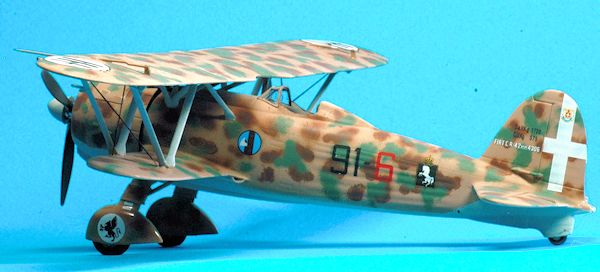 insertion of the exhaust stacks as well as getting
the exterior paint coverage into the section at the nose that connects with the
front cowl. The disadvantage of this is the engine air intake does not properly
attach to the cowl without leaving a noticeable gap. Part 40, which is the
engine air intake is added in step 6. This is where having the cowl as a one or
two part item with the intake portion (Part 40) under the cowl, that is moulded
with it rather than as a separate part would have been a better modeling
solution. But, if you have a multi-piece cowl as your design objective this
causes potential alignment problems. My vote is for a one piece crisply moulded
cowl…
insertion of the exhaust stacks as well as getting
the exterior paint coverage into the section at the nose that connects with the
front cowl. The disadvantage of this is the engine air intake does not properly
attach to the cowl without leaving a noticeable gap. Part 40, which is the
engine air intake is added in step 6. This is where having the cowl as a one or
two part item with the intake portion (Part 40) under the cowl, that is moulded
with it rather than as a separate part would have been a better modeling
solution. But, if you have a multi-piece cowl as your design objective this
causes potential alignment problems. My vote is for a one piece crisply moulded
cowl…
Step 8 has you assemble and attach the spats and landing gear. No surprises here except for the above mentioned misalignment gaps requiring filler putty. The spats required filler and sanding before attachment. Step 9/10 is the attachment of the windshield, aileron and rudder horns plus the venturi tube on the fuselage. The aileron and rudder horn linkages are a tad thick. I thought about replacing the long rod segments with some guitar wire. Due to the many other inaccuracies I found as I built this kit I did not think it was worth my time investment to fix these on this build. The rudder and aileron related small parts are too large and the ones Classic airframes used which are in etched metal, are a better example of staying in scale with small parts but the etched is not as easy to apply. The Italeri horns are easy to work with though so it is a tradeoff between finesse, ease of assembly and injection moulding tolerances. Note, part 39A, a sway support brace connecting the two spats has a forward sweep. Since there is no attachment key aligning it or preventing you from gluing it in backwards be aware of this and dry fit because you could attach it backwards. If you overlook this concern the join results in braces that fail to connect with the spats. The brace also serves as a nice alignment tool to keep the landing gear correctly aligned.
| COLORS & MARKINGS |
The decals come on a well printed sheet with six options. I chose the markings
for Tenente Enzo Martissa, R.A. 91 Squadriglia, 10 Gruppo 4th Stormo
while stationed in El Adem, Tobruk, Libya 1940 in the original delivery color
scheme of Giallo Mimetico 3 (FS.33434),
Marone Mimetico 1 (FS.30109) and Verde Mimetico 2 (FS.34092) . Verde
Mimetico 2 was applied using Testors Model Master # 2112 Italian Olive Green,
Model Master # 2111 Italian Dark Brown
mottle over a base layer of Model Master # 2110 Italian Sand enamels. The under
surfaces and wing struts were over Flat Light Gray (FS.36495) undersurfaces
using Gunze H306 acrylic.
Some similar color profiles of this aircraft were found in the MMP # 8104 CR.42
Falco text on page 139. I experienced some problems applying the decals. They
did not want to slide off the carrier sheet and I had to pry them off with
tweezers. Per haps humidity during storage activated the decal glue or I left
them in the water too long or not long enough?
haps humidity during storage activated the decal glue or I left
them in the water too long or not long enough?
The cockpit and related parts were painted in light gray – which was almost the
same color as the kit plastic! For the
overall fuselage finish I used Model Master Enamels in order to get exact color
matches. They worked very well and were more resistant to problems caused when
you apply additional layers of paint in a mottled finish since it is a complex
multi-layered camouflage. The propeller blade front was painted Grigio Azzurro
Chiaro, using Gunze H306 acrylic , as it came from the Fiat factory while the
back side facing the pilot was painted flat black.
Weathering and Final Coat – some pastel chalk and black/brown pin wash was used.
I sprayed on a Future coat used during the initial decal application and after
decaling was completed I used Future using a brush to seal all of the decals.
Testors Dull Cote was used during the final step to seal all of the decals and
give the correct flat finish.
The props had the correct decal stencil. The kit decal # 15 are the prop logos. They were supplied with the kit and look like the Hamilton Standard logo. It was so small I could not make out if the printing indicated a “FIAT” logo stencil on the prop since they are similar in shape and appearance the Hamilton Standard logo.
| FINAL CONSTRUCTION |
The kit looked decent once assembly was completed if you don’t look too closely.
I went over the kit to fix a number of
small gaps or incomplete joins with Tamiya putty and some Mr. Surfacer 500. One
of my biggest concerns was the gap between the fuselage cowl and engine air
intake. I had to use glue and clamps to mate these parts since they are separate
units. The intake should have been moulded as part of the cowl but that would
mean a loss of ease of manufacture since the other CR.42 versions have a dust
filter box at the tip of the intake. Classic Airframes took the same approach as
Italeri with this component. The CA kit has you cut off the tip and add a resin
dust filter box to the tip. That would have solved the gap problem I experienced
with Italeri.
The very last steps were attaching the wing bracing wires, the venturi and
engine with its cowl since I opted to paint the kit with the cowl off. That
allowed me to attach the exhausts after the cowl was painted and avoid
repainting them. I could do this because Italeri provided a keyed attachment
point for the engine to the fuselage. The only problem is the dust filter tunnel
and nose tip underneath the cowl
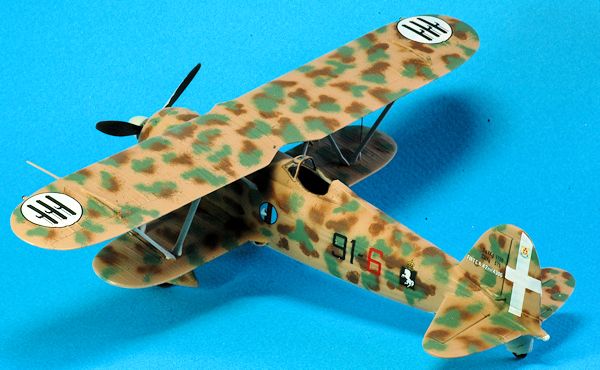 does not get attached as closely as I would
like. Normally I would attach the cowl and paint everything at the same time but
I did it this way to avoid having paint getting in behind the cowl flaps. That
could have affected the aluminum engine or inside cowl green zinc chromate
paint.
does not get attached as closely as I would
like. Normally I would attach the cowl and paint everything at the same time but
I did it this way to avoid having paint getting in behind the cowl flaps. That
could have affected the aluminum engine or inside cowl green zinc chromate
paint.
The wing tip lights were painted Testors chrome silver. The lights needed some filing and sanding because the upper and lower wing segments of the wing lights failed to correctly align. The first time I thought it was my error, but by the fourth kit it gave me an impression of weak quality in the moulds. If the lights would have been one piece units and part of either the top or bottom wing half this misalignment could have been avoided. When it was dry I used Tamiya clear red and green over the lights and the model was finished.
| CONCLUSIONS |
Italeri could have moulded their plastic parts much better and improved the kit
assembly process by doing so. Some of
the parts are somewhat crude, especially compared to other major plastic kit
manufacturers. Some parts were not the crisply moulded plastic I would have
expected from them. I always try to
be positive about a kit release since I truly appreciate a manufacturer making
the investment in new moulds, marketing and research.
I was really looking forward to Italeri’s release of this kit and to this
build. That makes me more kind and generous in my evaluation. As much as I like
the subject matter and trying as hard as I can, this is a situation where I
failed to be able to overlook the weak details and poor engineering given its
relatively high price.
All I can do is shake my head over thinking Italeri missed a big opportunity to
make a great kit. I hope they tackle the CR.32 and incorporate modelers
suggestions since that is also a gap in most 1/48th scale
collections. The CR.32 is much sought after by Regia Aeronautica builders. The
truth is if a kit is well engineered and thus easy to build, modelers will buy
it even if they are not a big fan of the genre – such as the Eduard Avia B-534
which is also a biplane. I had no knowledge nor interest initially in the Avia
B-534 until I saw how a delightful representation could be built from its
superior moulding and complimentary color etched parts.
The CR.32 was also, like the CR.42,
used by many other nations and produced in a variety of colorful paint schemes
and a kit review. Here’s hoping Italeri can make us happy next time with a good
CR.32 to re-establish their credibility and justify their product pricing. They
did much better with the MC.200 Saetta which came out after the CR.42 series so
Italeri demonstrated they can do it if they want to!
If you have ever watched the prices CA
CR.32’s go for on eBay, and the number of bidders competing you know there is a
demand for the CR.32.
The overall shape and dimensions of the kit are correct so don’t lose hope since
you can build a very nice model from this kit with a lot of care and application
of modeling skills to overcome kit deficiencies. I encourage you to build one
because some of the problems can be seen as a challenge to apply some modeling
skills and it’s part of the hobby. I am very pleased to look at this CR.42 now
that it is completed. I will build a few more when I can get them for a more
reasonable price. My finished kit may not be a contest ready model but it is
satisfying to have one built sitting on my model shelf and there are other
CR.42’s I would like to model.
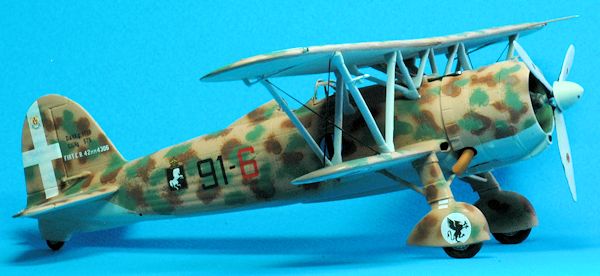 Despite the Italeri kit being an all styrene effort, I would say the Classic
Airframes CR.42 kit(s), second release series, is a competitive alternative to
Italeri in all respects. The CA kit has a much better cockpit with far more
accurate detail. You have to balance that with the inherent complexity of
working with mixed media including some thin and at times flimsy etched metal
bracing for the CA kit interior (in its first release), so be careful what you
wish for. The CA kit is more difficult to build with a far greater parts count
than the Italeri so there is a slight ease of assembly concern in the
comparison. Italeri has a much better engine and the CA engine has too many
parts. However, the CA resin interior and color etched metal parts are
impressive and not hard to work with compared to the Italeri plastic when it is
one of the components with a sloppy fit.
Despite the Italeri kit being an all styrene effort, I would say the Classic
Airframes CR.42 kit(s), second release series, is a competitive alternative to
Italeri in all respects. The CA kit has a much better cockpit with far more
accurate detail. You have to balance that with the inherent complexity of
working with mixed media including some thin and at times flimsy etched metal
bracing for the CA kit interior (in its first release), so be careful what you
wish for. The CA kit is more difficult to build with a far greater parts count
than the Italeri so there is a slight ease of assembly concern in the
comparison. Italeri has a much better engine and the CA engine has too many
parts. However, the CA resin interior and color etched metal parts are
impressive and not hard to work with compared to the Italeri plastic when it is
one of the components with a sloppy fit.
The exterior plastic detail on the CA kit, despite being a limited run effort,
is not as crisp in some areas as Italeri but in general on par with most of the
Italeri kit so you do have a choice. The CA kit comes with color etched metal
details. Italeri has no etched metal parts. Some of the CA parts use hard to
glue (i.e. requiring metal pins for a secure join) butt joins compared to the
Italeri keyed slots assembly. As Scott
mentioned it is an apples to orange comparison so it does depend on your
personal modeling abilities, choices and preferences. My point is don’t think
the newer kit which is all styrene is much easier to work with as it should be.
You can pick up CA’s CR.42 kits at good prices from some retailers and always on
eBay at a good price when it is a rational seller. Italeri’s current kit pricing
just doesn’t work for me leading me to consider Classic Airframes CR.42 as a
valid alternative on a value based comparison.
The Italeri kit is much easier to build than the Classic Airframes CR.42. Also,
the Italeri kit plastic moulding has many details missing from the Classic
Airframes kit such as a well moulded gun barrel(s)
(the CA kit advises you to create them
from plastic rod or 7mm tubes). I used some stainless steel tubing. Also missing
in the CA kit are the cowl cutouts for the gun blast tubes. That is, and it can
be seen on the Italeri kit, when the pilot opens the cowl flaps, there is a
cutout portion running under the tips of the machine guns so this operation will
not affect the unmovable gun tubes.
The CA CR.42 is missing the prominent oil cooler inlet at the front lower wing root and the oil cooler outlet at the rear of the lower wing root. This is provided on the Italeri kit. The pitot tubes found on the front edge of the wing spars are missing on the CA kit. They are part of the Italeri kit plastic. There is no location hole on the starboard fuselage for the location to attach the resin venturi tube on the CA kit. You need to determine the spot and drill a hole on the CA kit. The hole is part of the Italeri kit plastic. The two upper wing leading edge formation lights are missing on the CA kit. You need to scratch build or add these. Italeri provides them.
As mentioned before the two fuselage machine gun barrels are missing. They are
part of the Italeri kit plastic.
The CA kit instructions do advise you to add some machine gun barrels from rod
or tube but that does not provide for a good representation of the shape of the
Breda-SAFAT guns barrels and tips. There is an excellent brass barrel machine
gun replacement available from Master Models brass parts but that adds about 30%
to the cost of a kit which unless you love the subject matter, you might avoid
building or stop construction after too many building challenges or surprises.
Also missing from CA’s kit are the rudder linkage and actuating arms and the
same parts for the stabilizer. They are part of the Italeri kit plastic. The CA
kit does provide the four sets of linkage and actuating arms required for the
upper wing aileron but compared to actual photos of the aircraft the linkages
are too short. I used some guitar wire replacements for the parts to get a
longer rod. The upper wing on the CA kit is missing the pilot grab handle cut
into the trailing edge of the upper wing over the cockpit. CA has it as a
recessed panel outline but it is filled in – you will need to cut the hole since
it was an opening. Most of these
missing items are very visible in the color photos found in the Italeri C.R. 42
Falco photographic reference manual.
One of the biggest omissions in comparing the CA kit to this Italeri release is
the missing and very prominent oil cooler inlet at the front lower wing root and
the oil cooler outlet at the rear of the lower wing root. This is provided on
the Italeri kit. The pitot tubes found on the front edge of the wing spars are
missing on theca kit. They are part of the Italeri kit plastic. There is no
location hole on the starboard fuselage for the location to attach the resin
venturi tube. You need to determine the spot and drill a hole on the CA kit. The
hole is part of the Italeri kit plastic.
As Scott said, it is actually an apples to oranges comparison of the same
subject matter.
| REFERENCES |
Fiat CR 32/CR 42 In Action, # 1172 by George Punka, Squadron Signal Books 2000
Profile Publications No. 16 FIAT Cr.42
C.R. 42 Falco Italeri Kit # 2653 booklet, 2006
Fiat Cr.42 Ali e'Colori No. 1 La Bancarella Aeronautica
SKYmodels decal 'Fiat CR.42', # 48-036 and 48-037
Fiat CR 42, Ali D’Italia #1, La Bancarella Aeronautica, 1995
International Air Power Review, November 2005, Vol. 17,
pages 158 to 173.
October 2013
If you would like your product reviewed fairly and fairly quickly, please contact the editor or see other details in the Note to Contributors.